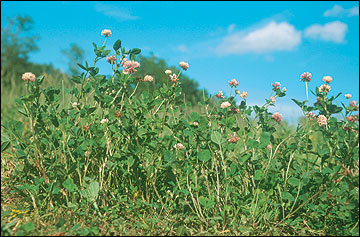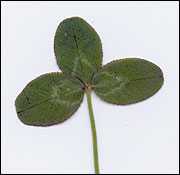Alsike clover (Trifolium hybridum L.)
Legumes
Alsike clover is a short-lived perennial grown on an estimated 300,000 acres in Missouri. Alsike clover’s claim to fame is that it tolerates wet, heavy soils and flooding better than most other legumes. Alsike clover stems are weak, and the plant lodges easily. For this reason, it is almost never grown in pure stands and is only seldom used for hay. Although it is not as productive as red or white clover, alsike clover withstands grazing well. It produces best in a rotational grazing system where it is grazed to a 3-inch stubble height every 28 to 35 days. Alsike clover’s nutritive value is similar to white clover, and cattle find it palatable.
 Alsike clover
Alsike clover
 Yield distribution of alsike clover in Missouri.
Yield distribution of alsike clover in Missouri.
- Origin: Northern Europe
- Adaptation to Missouri: Statewide
- Growth habit: Semi-erect to prostrate, short-lived perennial.
- Leaf: Trifoliolate leaves are stalkless with glabrous, obovate, toothed margins.
- Stems: Smooth and slender, often hollow.
- Stipules: Large, glabrous, taper to a point, wrap around leaf stems.
- Flowers: White to pinkish rose and forms a dense round head. Flowers are borne along the length of the stem, with youngest flowers at top.
- Fertilization: No N needed if nodulated. Maintain 30 lb/acre P and 250 lb/acre K.
- Timing of production: 70 percent of annual production between April 1 and June 30.
- When to begin grazing: Often based on the height of the grass in the mixture. Few if any pure stands exist.
- When to cut for hay: Not normally cut for hay unless it is mixed with a companion grass. Harvest based on the maturity of the grass.
- Lowest cutting or grazing height: 3 inches
- Fall management: Avoid severe grazing from Sept. 15 until the first hard killing frost

